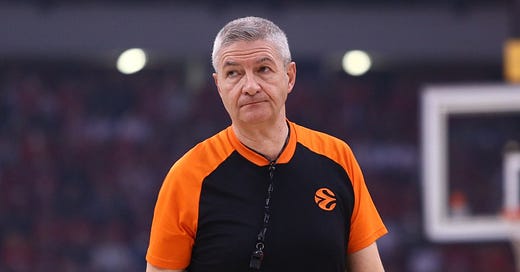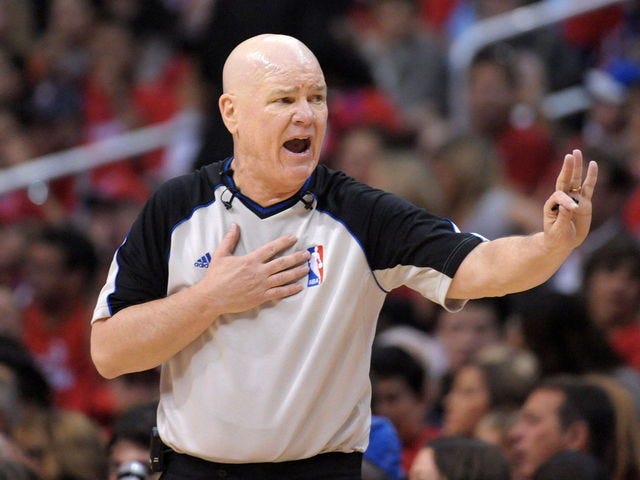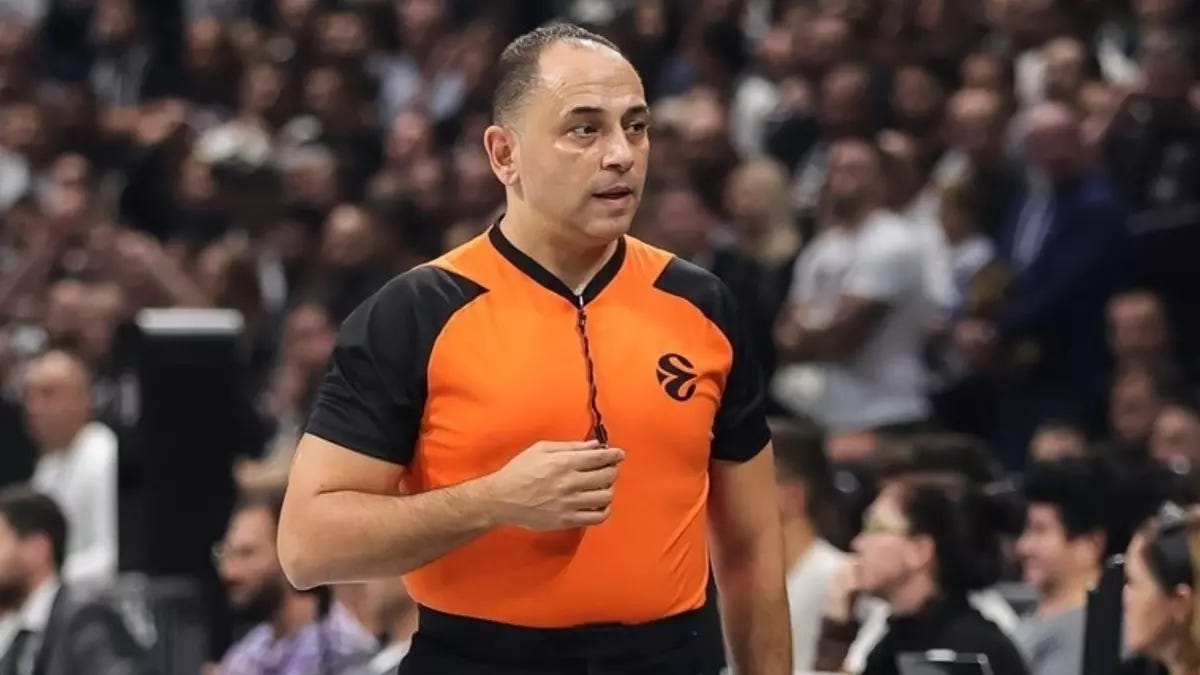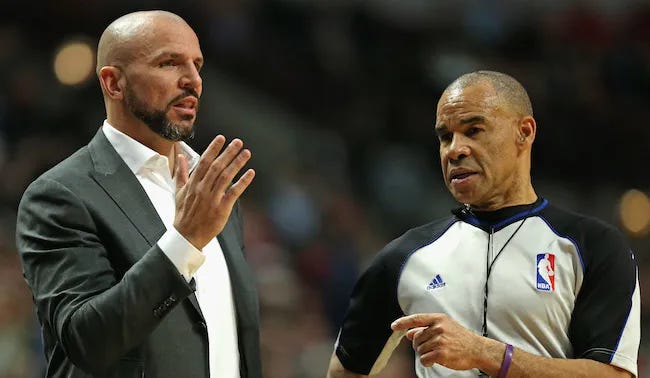When you step onto the court as a crew chief, you carry more than just a title; you carry a responsibility. The role isn’t defined by authority alone, but by the nuances of leadership, trust, and growth. And yet, it’s a role often misunderstood.
Leadership on the court isn’t about titles, it’s about action, understanding, and balance. To truly embody what it means to be a crew chief, it’s not enough to look at what the role is, you also have to understand what it isn’t.
What’s a Crew Chief?
A crew chief is, first and foremost, a leader. But leadership in officiating is a practice, not a position. It’s a quiet resilience, a steady hand in chaos, and an instinctive understanding of when to act and when to trust.
The crew chief provides structure and stability, not by controlling every moment but by creating an environment where the entire crew can operate confidently. Your job isn’t to see and know everything; it’s to trust the officials you’re working with while stepping in only when necessary.
Leadership begins where trust lives.
And trust doesn’t mean turning a blind eye to missteps. Whether it’s a marginal foul call, a missed rotation, or miscommunication with players or coaches, the ability to recognize and address these mistakes defines the best crew chiefs. Timing here is essential. The first timeout or a game interval becomes a crucial window to discuss what went wrong, but delivery matters as much as timing.
Every referee is different. Some respond well to direct feedback; others need a softer, more constructive tone. As a crew chief, understanding your crew’s dynamics and tailoring your communication to empower, rather than discourage, isn’t just part of the job; it *is* the job.
Leadership isn’t universal; it’s deeply personal.
What’s NOT a Crew Chief?
The title of “crew chief” doesn’t grant you the power to control everything, nor does it demand perfection. If anything, being a crew chief is about recognizing the limits of control while embracing the opportunities within imperfection.
You are not a dictator. Leadership isn’t about issuing commands; it’s about promoting teamwork. A crew chief who silences their crew or dismisses their perspectives quickly finds themselves isolated.
The greatest strength of any team lies in its unity, and that begins with the leader.
You are not a lone wolf. The idea that a crew chief must bear the weight of every decision, every error, and every call alone is an easy trap to fall into, something that can limit both you and your crew’s performance. Your role is to draw the best out of your crew, helping them be their best self when they are with you. Nobody expects a one-man show.
Better to remember, you are not all-seeing or all-knowing. The myth of the “omniscient”1 crew chief can derail even the most experienced officials. It’s impossible to track every play, every moment, every call.
What separates a great crew chief isn’t their ability to see everything, but their ability to respond effectively and solve the problems when it matters most.
The Role in Action
As a crew chief, one of your primary responsibilities is to recognize and respond to moments when your crew needs guidance, especially after mistakes or moments of doubt. These instances are pivotal, and how you handle them can shape the rhythm of the game and the confidence of your team.
When a member of your crew makes a mistake, like a marginal call or a decision they may second-guess, it can subtly affect the game’s flow. That’s when the crew chief must pay attention to the signs: hesitation in their body language, delayed reactions, or a loss of confidence that affects subsequent plays. Your role in these situations is to step in with clarity and purpose, ensuring the crew regains its focus and composure.
You can consider these guiding principles as you step into action:
Use the Next Timeout or Game Break Wisely
Timing is everything. The first game break—whether it’s a timeout, quarter break, or another pause—is your opportunity to address the situation. Waiting too long can allow doubt to fester, while immediate intervention may not give your partner the space to settle mentally.Start with a Question, Not a Critique
Begin by asking, “What did you see?” This approach creates a dialogue and allows your partner to articulate their perspective. It shows you’re there to listen first, not to criticize, and encourages them to refocus on their decision-making process.Provide Reassurance When Needed
Often, officials already know when a call could have gone either way. Critiquing the decision in the moment is rarely productive. Instead, remind them to trust their instincts, to follow your pre-game plan, and encourage them to focus on the next play. Confidence is built through support, not scrutiny.Keep the Focus on Recovery
The goal isn’t to dwell on the mistake but to help your crew reset and move forward. Acknowledge the moment, offer your guidance, and shift their attention to what’s coming next. Leadership in these situations is about clarity, not creating more pressure.
Moments like these define your role as a crew chief. It’s not about perfection; it’s about creating a space where your team can recover, recalibrate, and perform at their best. By guiding your crew back to track, you ensure the game and your officiating team move forward with confidence and balance.
Finding Balance
The true challenge of being a crew chief lies in the balance. You’re constantly walking the line between authority and empathy, structure and intuition, discipline and flexibility. It’s a delicate harmony, requiring you to adapt to the unique dynamics of every game, every crew, and every moment.
At the heart of this balance is trust, trust in yourself and trust within your crew. And trust begins with authenticity.
The concept of authentic leadership offers a powerful framework for the role of a crew chief. Authentic leadership emphasizes self-awareness, relational transparency, and leading with consistency and integrity. It’s about knowing who you are, staying true to your values, and creating an environment where others feel empowered to do the same.
In many ways, this authenticity becomes your personal brand as a leader. The way you carry yourself on and off the court, how you communicate with your crew, and the decisions you make under pressure, these all contribute to the identity you build as a crew chief. Your personal brand isn’t about perfection; it’s about consistency, values, and the trust you cultivate over time.
For example, ask yourself: what do you want your crew to say about you after the game? Do they see you as someone who listens and leads with empathy? Someone who remains calm under pressure? Someone who treats every challenge as an opportunity for growth? This is your personal brand in action.
When a colleague tells you, “I’m a better referee when you’re my crew chief”, that’s when you know you’ve succeeded.
Building that brand doesn’t happen overnight, and it’s not about creating a surface. At its depth, it’s about showing up as your authentic self in every game; genuine, self-aware, and committed to the game and your team. It’s about embracing the hard conversations, guiding your crew through problems, and modeling the resilience you hope to inspire in others.
Why It Matters
The legacy of a great crew chief isn’t measured by flawless execution; it’s measured by the trust you create, the clarity you bring, and the growth you inspire. It’s the way you guide your crew through challenges, not by solving every problem, but by empowering them to solve problems together.
Being a crew chief isn’t about perfection. It’s about progress. It’s about learning when to lead, when to listen, and when to let the game unfold as it should, not as a dictator, but as a guide.
It’s about leaving the court better than you found it. Not just for the players, but for your team and yourself.
To be a crew chief is not just to officiate. It’s to lead, to grow, and to inspire.
Omniscience is the property of possessing maximal knowledge. In Hinduism, Sikhism and the Abrahamic religions, it is often attributed to a divine being.







